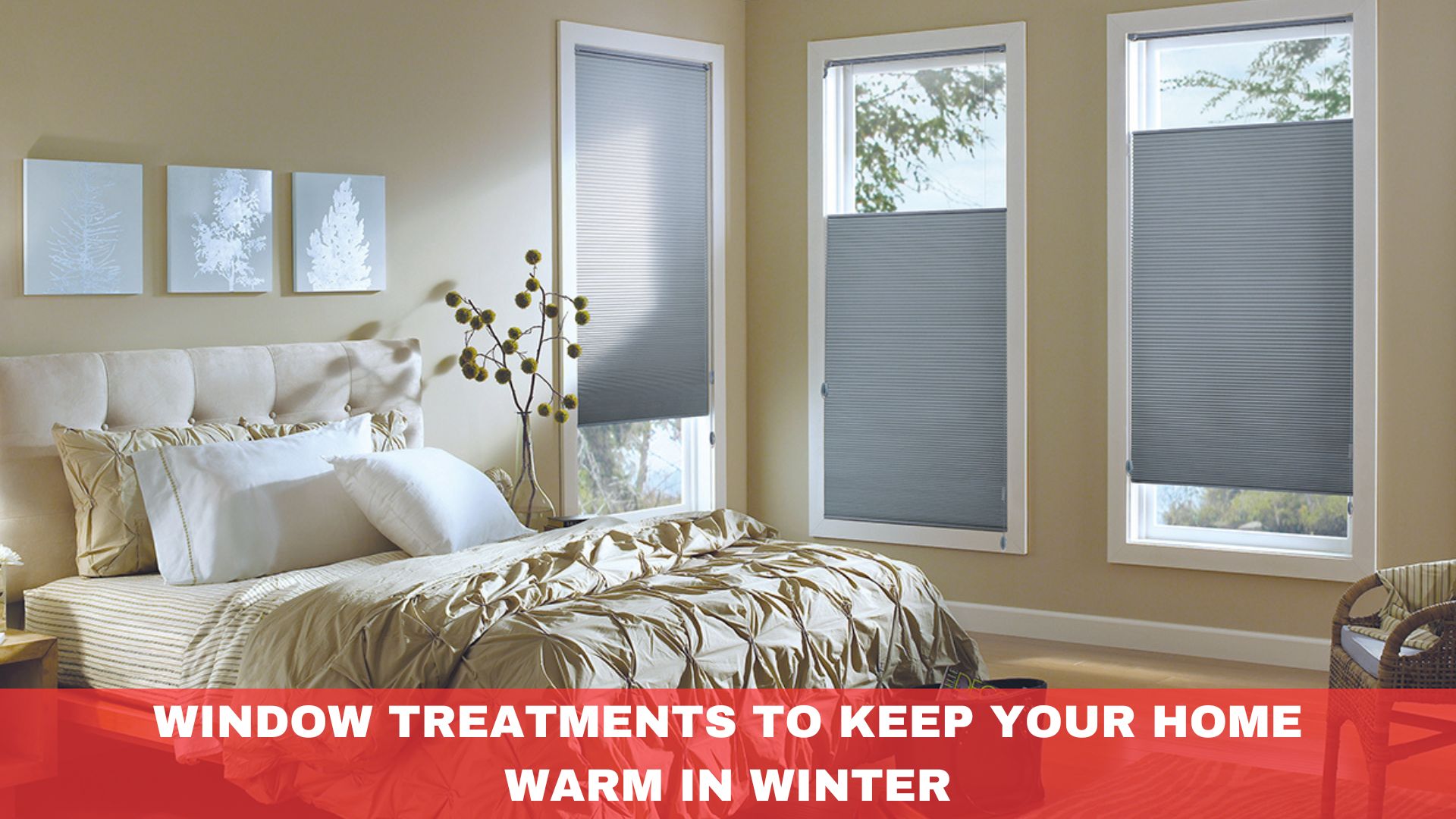Are you tired of chilly drafts and soaring heating bills during the winter months?
Inefficient windows can be a significant source of heat loss, making your home uncomfortable and costing you a fortune.
The right window treatments can make all the difference! By choosing energy-efficient options, you can transform your windows into robust insulators, keeping your home warm and cosy while saving you money. Let’s explore the best window treatments to warm your home this winter.
Best Window Treatment Options For Winter Warmth
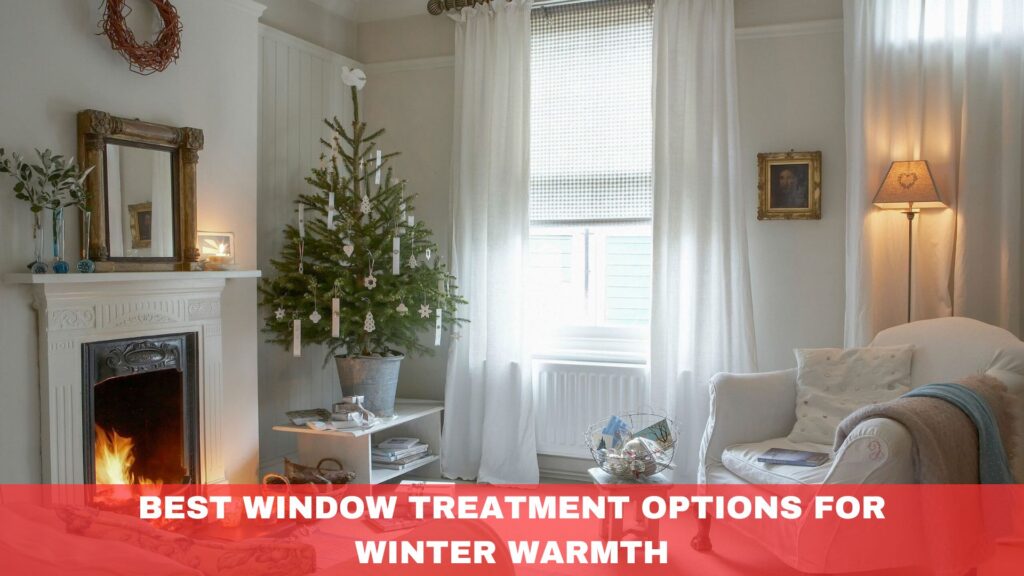
Choosing the right window treatments can make a significant difference in keeping your home warm during winter.
Below are five top options that excel in insulation and energy efficiency:
1. Thermal Curtains
Thermal curtains keep your home warm by preventing heat loss through windows. They feature thick, often layered fabrics that provide excellent insulation properties. The key to their effectiveness lies in their ability to trap heat inside during colder months and block out drafts that can chill a room.
Look for curtains with a thermal lining or backing, which enhances their insulating capabilities. These linings can be made from materials like acrylic foam, fleece, or thermal weaves, creating a barrier against cold air from the outside.
Velvet, suede, or heavy cotton fabrics are famous for thermal curtains due to their density and heat-retaining properties.
When choosing thermal curtains, consider their length and width to ensure they fit snugly against the window frame. This prevents air from circulating the edges, maximising their efficiency.
Regularly cleaning and maintaining thermal curtains is essential to retain their insulating qualities.
Investing in thermal curtains helps maintain a comfortable temperature indoors and reduces heating costs by minimising the need for additional heating during winter.
2. Cellular Shades
Cellular shades, also known as honeycomb shades, are highly regarded for their ability to provide excellent insulation and energy efficiency in homes during winter. Their distinctive honeycomb structure traps air within the cells, creating a barrier that prevents heat loss through windows.
The design of cellular shades allows them to act as a buffer against cold drafts, helping to maintain a comfortable indoor temperature. They come in single-cell or double-cell options, with double-cell shades offering enhanced insulation due to an extra layer of cells.
These shades are available in various materials and opacities, allowing you to choose the level of light control and privacy that suits your needs. Options include light-filtering, room-darkening, and blackout fabrics.
For optimal performance, ensure cellular shades are installed correctly to minimise gaps where heat can escape. Regular cleaning with a soft brush attachment on a vacuum or gentle dusting with a cloth helps maintain their efficiency.
3. Roman Blinds with Thermal Linings
Roman blinds with thermal linings are an excellent choice for homeowners seeking aesthetic appeal and effective insulation during winter. Their classic folding design adds elegance to any room while providing practical benefits.
The thermal linings incorporated into Roman blinds enhance their ability to retain heat and block cold drafts from entering through windows. These linings are typically made from insulating materials such as acrylic foam or thermal weaves, which create a barrier against outside temperatures.
When selecting Roman blinds with thermal linings, consider the fabric and thickness of the materials used. Fabrics like heavy cotton, suede, or thicker weaves offer superior insulation properties.
Roman blinds’ design allows them to be adjusted easily, providing flexibility in light control and privacy while maintaining warmth indoors.
Regular maintenance involves gentle cleaning to preserve the thermal properties of the linings. Vacuuming with a soft brush attachment or light dusting with a cloth is recommended to remove dust and debris without damaging the fabric.
4. Insulated Roller Blinds
Insulated roller blinds offer a streamlined and practical option for maintaining warmth in your home during winter. These blinds are crafted from materials that provide effective insulation against cold temperatures and drafts from windows.
The critical feature of insulated roller blinds is their thick, insulating fabric or backing. This material is designed to trap heat indoors and prevent it from escaping through windows. Look for blinds made from thermal fabrics or those with additional insulating layers for optimal performance.
When choosing insulated roller blinds, consider the opacity and colour of the fabric. Darker colours absorb more sunlight, which can warm the room naturally during daylight hours. Light-filtering or blackout options provide varying light control and privacy levels while enhancing insulation.
Regular cleaning and maintenance are essential to preserve the insulating properties of roller blinds. Vacuuming with a soft brush attachment or wiping with a cloth helps remove dust and maintain their efficiency over time.
Insulated roller blinds enhance comfort by keeping rooms cosy and contribute to energy efficiency by reducing heating costs. Their straightforward design and functionality make them a practical choice for any home seeking effective winter warmth solutions.
5. Layered Treatments
Layered window treatments combine multiple elements to enhance insulation and energy efficiency during winter months. You can achieve optimal warmth and comfort while enhancing aesthetic appeal by strategically pairing different blinds, shades, or curtains.
Start with a base layer of thermal curtains or heavy drapes that provide significant insulation against cold drafts. Thermal curtains with a dense fabric or thermal lining are ideal for trapping heat indoors and reducing heat loss through windows.
Add a secondary layer of cellular shades or Roman blinds with thermal linings for additional insulation and light control. With their honeycomb structure, cellular shades create an air pocket that acts as a barrier against outside temperatures.
Roman blinds offer style and functionality, especially thermal linings from insulating materials like acrylic foam or fleece.
The combination of layered treatments allows flexibility in adjusting light levels and privacy preferences while maintaining warmth indoors. Ensure proper installation and fit to minimise gaps where heat can escape.
Layering Techniques For Enhanced Insulation
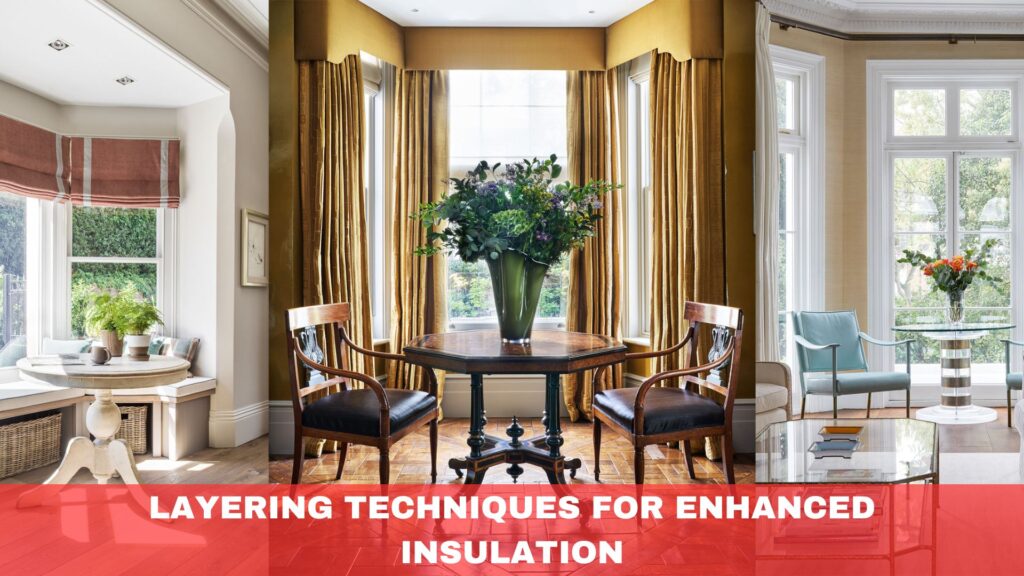
Layering window treatments strategically can significantly enhance insulation and energy efficiency in your home during winter.
Below are four effective techniques to consider:
1. Thermal Curtains with Cellular Shades
Pairing thermal curtains with cellular shades is highly effective for enhancing insulation and keeping your home warm during winter. This dual-layered approach leverages the strengths of both treatments to provide superior thermal efficiency.
Thermal curtains are crafted from heavy fabrics or feature thermal linings that provide a robust barrier against cold drafts. They prevent heat loss and add a sound insulation layer, creating a more comfortable indoor environment. When closed, thermal curtains block the cold air from entering and keep the warm air inside.
Cellular shades, also known as honeycomb shades, have a unique structure that traps air within their cells. This trapped air acts as an insulating layer, reducing heat transfer between the window and the room.
Cellular shades are available in various cell sizes, with double or triple-cell options offering the highest level of insulation. When used together, thermal curtains and cellular shades provide adjustable light control and enhanced privacy.
Cellular shades can be adjusted daily to allow natural light while maintaining insulation. At night, drawing the thermal curtains adds an extra layer of warmth.
2. Roman Blinds over Thermal Curtains
Layering Roman blinds over thermal curtains is an effective way to enhance insulation while adding a touch of elegance to your home. This combination leverages the insulating properties of both treatments to create a cosy and energy-efficient environment during winter.
Roman blinds are known for their stylish design and functionality. When equipped with thermal linings, they provide an additional barrier against cold air, helping to retain warmth inside your home. These blinds can be easily adjusted to control light and privacy, making them a versatile choice for any room.
On the other hand, thermal curtains are designed with thick fabrics or insulating linings that block drafts and prevent heat loss through windows. They offer substantial thermal protection, keeping your living spaces warm and comfortable when drawn.
You achieve a dual-layered insulation effect by layering Roman blinds over thermal curtains. During the day, the Roman blinds can be partially or fully opened to allow natural light while the thermal curtains remain closed to maintain warmth. Both treatments can be drawn at night to maximise insulation, effectively reducing heat loss and energy costs.
3. Double-layered Roller Blinds
Double-layered roller blinds offer an innovative solution for enhancing insulation in your home during winter. These blinds feature two layers of fabric that work together to provide superior thermal efficiency and versatility in light control.
The first layer typically consists of a sheer or light-filtering fabric that allows natural light to enter the room while maintaining privacy. This layer is ideal for daytime use, brightening the space without compromising insulation.
The second layer is made from a thicker, insulated material that blocks cold air and retains heat. This thermal layer is crucial for keeping your home warm during the colder months.
Double-layered roller blinds can be adjusted to use either layer independently or both layers together, providing flexibility in managing light and insulation needs.
During the day, you can keep the sheer layer down to enjoy natural light while keeping the insulated layer rolled up. At night, lowering both layers enhances insulation, reducing heat loss through the windows.
These blinds are available in various colours and styles, allowing you to match them with your home décor while benefiting from their insulating properties.
Proper installation ensures minimal gaps, maximising their effectiveness. Double-layered roller blinds are a practical and stylish choice for maintaining warmth and energy efficiency in your home during winter.
4. Sheer Curtains with Heavy Drapes
Layering sheer curtains with heavy drapes is an effective technique for enhancing insulation and maintaining a comfortable indoor temperature during winter. This combination offers functional and aesthetic benefits, providing light control and privacy flexibility while significantly improving thermal efficiency.
Sheer curtains are lightweight and allow natural light to filter into your room, creating a bright and airy atmosphere. They offer privacy without completely blocking the view, making them ideal for daytime use. However, sheer curtains alone do not provide much insulation against cold drafts.
Heavy drapes, on the other hand, are made from thick fabrics such as velvet, wool, or thermal-lined materials. These drapes are designed to block cold air from entering and prevent heat from escaping, thus enhancing the insulation of your windows. When closed, heavy drapes provide a substantial barrier against the cold, keeping your home warm and cosy.
Combining sheer curtains with heavy drapes allows you to adjust the layers according to your needs. During the day, keep the sheer curtains drawn to enjoy natural light while the heavy drapes remain open. At night, close the heavy drapes to maximise insulation and retain heat.
This layering technique improves thermal comfort and adds depth and texture to your window treatments, enhancing the overall décor of your home. Proper installation and regular maintenance ensure that both layers function effectively, providing a stylish and practical solution for winter insulation.
Additional Tips For Maximising Warmth
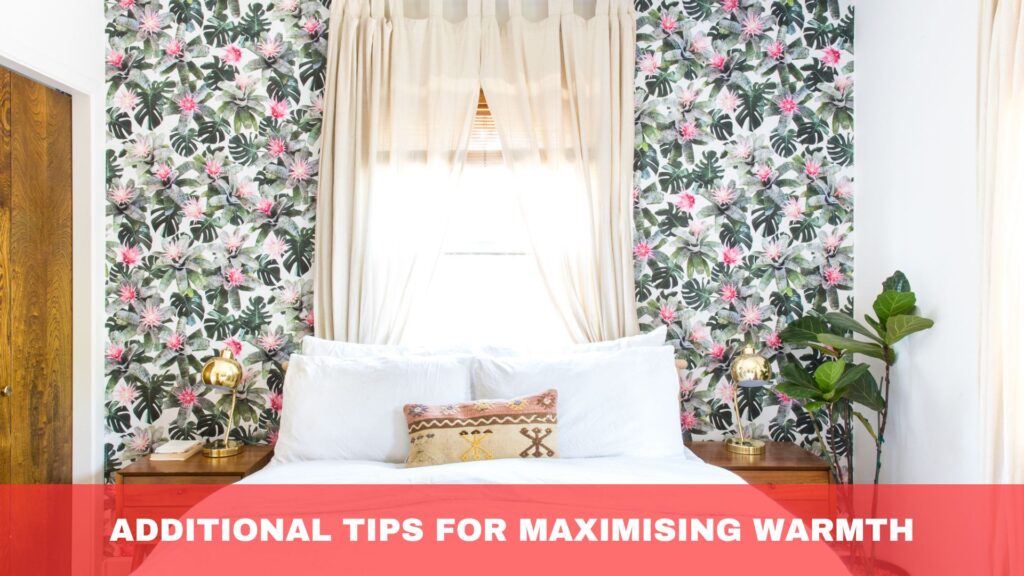
To ensure your home remains warm and cosy during winter, consider these additional tips for maximising the effectiveness of your window treatments:
1. Proper Installation
Proper installation of window treatments is crucial for optimal insulation. Ensure that blinds, curtains, and shades are fitted snugly against the window frame to minimise gaps where cold air can enter and warm air can escape.
Measure accurately and follow the manufacturer’s installation guidelines for inside mounts. Extend the coverage beyond the window frame for outside mounts to create a more effective barrier.
2. Use of Draft Stoppers and Seals
Draft stoppers and seals enhance the insulating properties of your window treatments. Install weatherstripping around the edges of windows and doors to prevent drafts. Draft stoppers, which can be placed at the base of windows and doors, provide additional protection against cold air infiltration.
3. Night-Time Insulation
Maximise warmth by closing all window treatments at night. Heavy drapes, thermal curtains, and layered therapies should be fully drawn to retain heat accumulated during the day. During daylight hours, open them to allow natural sunlight to warm your home, but close them before temperatures drop in the evening.
Benefits of Energy-Efficient Window Treatments
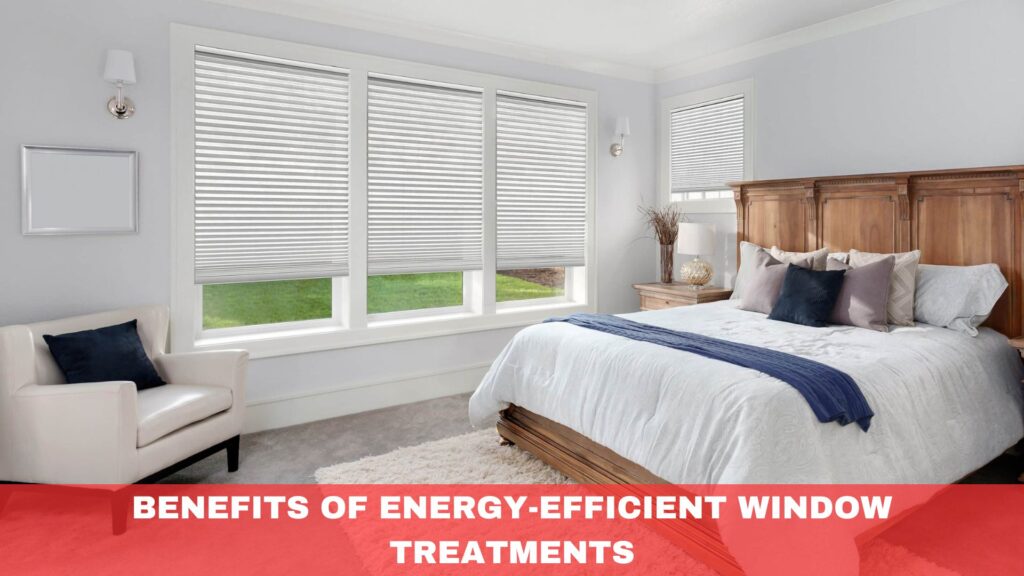
Investing in energy-efficient window treatments offers numerous advantages, particularly during winter. Below are four key benefits to consider:
- Cost Savings: Energy-efficient window treatments reduce heating costs by minimizing heat loss through windows. They provide an extra layer of insulation, maintain a consistent indoor temperature, and reduce the need for additional heating. Over time, this leads to significant savings on energy bills, making them a cost-effective investment.
- Enhanced Comfort: Energy-efficient window treatments prevent cold drafts and retain warmth, ensuring a cosy indoor environment during winter. This improved insulation contributes to a stable and pleasant indoor climate, enhancing overall comfort.
- Environmental Impact: Lowering energy consumption with energy-efficient window treatments reduces your home’s carbon footprint. This supports a more sustainable lifestyle and helps combat climate change by decreasing the energy required to heat your home.
- Increased Property Value: Homes with energy-efficient features, including window treatments, often have higher market value. Energy-saving attributes are increasingly attractive to potential buyers, making your home more appealing and valuable.
Conclusion
Selecting the right window treatments is essential for maintaining warmth and energy efficiency during winter. Explore our range of thermal curtains, cellular shades, and layered options at Into Blinds Melbourne.
Enhance your home’s comfort and reduce heating costs today – contact us for expert advice and tailored solutions.

